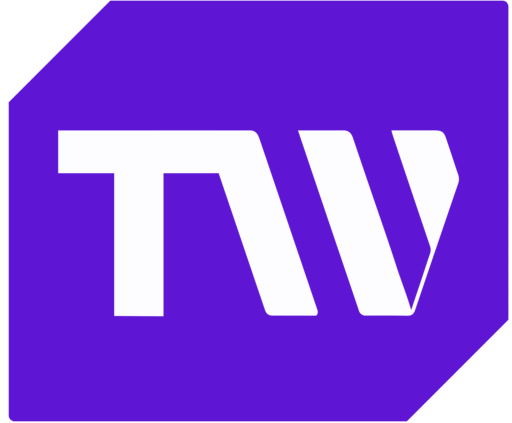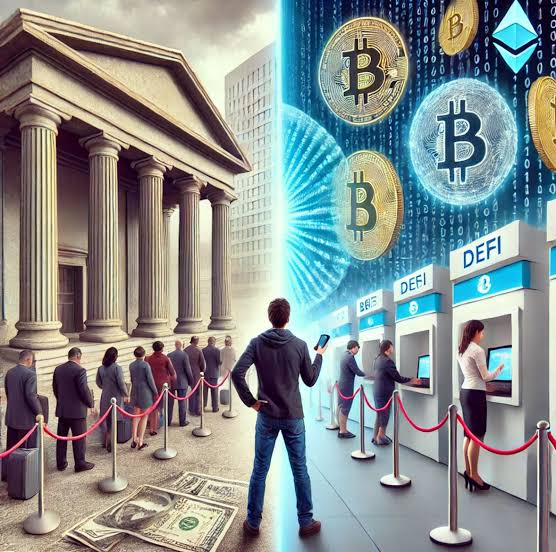The Internet Financial System: A Crypto-Powered Paradigm Shift
In 2025, the global financial order will undergo a major transformation in the same way that Johannes Gutenberg’s printing press revolutionized information transmission in the 15th century (Gutenberg Project). This transformation is not limited to cryptocurrency, blockchain,or decentralized finance (DeFi) ; it’s about all of them coalescing into what we call the Internet financial system.
This is not finance merely communicated over the Internet, as with logging into your bank account. It is finance built on the Internet, open, permissionless, and powered by cryptographic innovation. At its core, this system leverages the unique properties of crypto technologies like Bitcoin and Ethereum to create a unified, scalable infrastructure that promises to hold the world’s assets and deliver financial services to all 8 billion people on Earth.
Image Source: interactivecrypto.com
Beyond Labels: Why “Internet Financial System”?
The term “Internet financial system” might raise eyebrows among crypto enthusiasts accustomed to buzzwords like “blockchain,” “DeFi,” or “crypto.” Why not stick with those? The answer lies in scope and clarity. “Decentralized finance,” as tracked by platforms like DeFi Llama, captures part of the vision, permissionless, intermediary-free financial services, but it’s too narrow.
The internet financial system, on the other hand, focuses on a specific objective: replacing the traditional global financial system with lower-cost, more accessible services via unified, permissionless servers. For example, Circle’s USDC, a stablecoin pegged to the U.S. dollar with over $34 billion in circulation as of 2023 (CoinMarketCap), dominates as a product with undeniable market fit. Is it DeFi, or a more effective, centralized system running on blockchain rails?
Traditional finance functions similarly like placing an online pizza order. Your order pings a separate, analog pizza place that prepares and delivers in the real world; the internet is merely a communication layer. In a similar vein, when you send money, the internet only forwards your request to a permissioned database that is not visible to the public internet.
The assets themselves; stocks, currencies, and land titles live on publicly accessible, crypto-secured ledgers such as Ethereum’s blockchain, Etherscan in the online financial system. Root access to these databases is available to everybody, anywhere, and is confirmed by cryptographic proofs rather than suit-wearing middlemen.
The Siloed Legacy: A Topology of Constraint
To grasp why this matters, consider how ownership works in the legacy system. If you invest in a startup, your equity might be recorded on a spreadsheet, replicated perhaps on a cap table platform, or with a lawyer. That spreadsheet is your ownership, no global ledger reflects it.
Buy Apple stock on brokerage app? Your 100 shares exist as a database entry on their servers. Apple doesn’t know you own them; only a clearinghouse links you indirectly to the company. In less advanced systems, like owning land in a Guatemalan village, your title might be a rolled-up map in a government office, secured by signatures and prone to loss or corruption.
This is a topology of silos: disparate, permissioned databases loosely connected by internet communication. Moving assets between them i.e transferring stock between brokers requires layers of approvals, intermediaries, and fees. Sending money from the U.S. to Europe involves more workers shuffling database entries. In Guatemala, transferring land might mean flying there, hiring lawyers, and navigating dozens of signatures. These high transaction costs stifle innovation and access, locking capital in inefficient, expensive systems.
Crypto changes this. On a blockchain like Ethereum, assets are tokenized, stocks as ERC-20 tokens, land titles as NFTs are recorded on a unified, permissionless ledger. Sending a token from one wallet to another updates a single database entry, instantly and at near-zero cost (Ethereum Gas Tracker). No intermediaries, no silos, just a server on the open internet, governed by immutable smart contract code.
The Crypto Unlock: Permissionless Innovation
The power of crypto lies in its permissionless nature. High entry hurdles stifle financial innovation in the legacy system. Regulation and economies favoring giants caused the the number of new insured banks in the U.S. to plummet to zero after 2008. (FDIC Statistics). Five banks control more than half of the market worldwide, accounting for 82% of the market in South Africa and more than 50% in other emerging economies.
These banks operate as oligopolies, overcharging for loans and providing subpar services. (World Bank Financial Structure). The pricing power is reflected in Net interest margins (NIMs), which are the difference between what banks pay depositors and what they charge borrowers (Investopedia on NIM). In an open system, new entrants would compress high NIMs, which indicate limited competition. However, permissioned silos prevent this.
Crypto flips the script. Bitcoin’s 21-million-coin cap, enforced by its blockchain (Bitcoin Whitepaper), was the first credible commitment, a promise no nation-state could pinky-swear and keep. Ethereum improved this with smart contracts (Ethereum Whitepaper), enabling developers to encode any financial logic into permissionless servers.
Use Eric Budish’s batch auction idea to reduce high-frequency trading. When it was proposed in the early 2000s, it was sluggish in traditional exchanges where permissioned gatekeepers profited from the status quo. According to CowSwap Stats, the CowSwap team implemented crypto on Ethereum, processing a volume of $90 billion. Anyone can experiment with permissionless systems, spurring innovation that has not been seen in legacy finance for decades.
Image source: researchleap.com
Credible Commitments and Servers with Laws
This change is centered on what cryptocurrency refers to as “credible commitments.” Ethereum pledges to carry out smart contracts exactly as they are stated, while Bitcoin pledges to produce 21 million coins (Solidity Docs). These are technological guarantees that are upheld by decentralized networks rather than assurances from a bank or the government. “Servers with laws” refers to unified databases on the Internet that are regulated by code that is more dependable than many nation-state laws.
In the fragmented, expensive legacy world, a smart contract that pays royalties per song stream or issues revenue-share tokens for 200 retailers is not practical. On Ethereum, it’s insignificant. (OpenZeppelin Contracts).
The former patchwork of isolated servers is reversed by this. Capital moves directly rather than through a web of middlemen; Dubai funds lend to Colombian vehicle loans at 8% interest, paying borrowers 20%, bypassing the gatekeepers. The catch? Legal frameworks need to coincide. If the local police do not enforce repossession, a tokenized residence is worthless. However, the final mile is close due to the scalability of crypto. Ethereum’s transactions per second (TPS) are now sufficient for mass adoption (L2Beat)—and regulatory tailwinds, such as the U.S. stablecoin law (CoinDesk on Stablecoin Regulation).
Sovereignty and Friction: Crypto vs. Nation-States
Here’s where it gets thorny: these servers with laws function at a higher order than nation-state laws. Bitcoin’s 21-million-coin cap cannot be altered by tanks or legislation; Ethereum’s contracts execute independent of sanctions. Friction results from this. Systems outside of their authority are unfamiliar to nation-states. The reason Tornado Cash developers were arrested was not because the code was stopped, but rather because people are still subject to the law. (CoinTelegraph on Tornado Cash)
However, the situation affects this friction. Crypto enhances established institutions in nations with strong rule of law (the U.S. has a 95 property rights score, according to the Heritage Foundation Exporting its assets, such as stablecoins or tokenized Apple shares, might benefit the United States by reducing its cost of capital if demand rises internationally. Crypto provides a lifeline in countries with weak rule of law (average score: 43), where corruption and expropriation are rampant (Heritage Property Right Index).
Bitcoin allowed Brazilians and Nigerians to own their first “real” property, which was unaffected by regional whims. American property rights may soon be extended globally through tokenized U.S. assets, which would change savings from -65% (currency depreciation) to +10% (stock appreciation) during a 15-year period (World Bank Currency Data). Blockchain technology, such as NFT land registries or on-chain governance, may eventually be used by nations to fortify their own legal frameworks, attracting investment to high-ROI emerging economies.
The Crypto Journey: From Speculation to Substance
Why, therefore, has this goal not been realized in its entirety by 2025? The history of cryptocurrency shows both potential and danger. FTX’s demise, meme coins, and millennials’ financial nihilism all contributed to speculation during the zero-interest-rate era as they gambled to get out of the rat race. There was widespread capital misallocation; during a conference, a $400 million token party frequently outperformed actual product-market fit. Five years ago, scalability was lacking; on-chain funds ran the danger of hacking, and trades cost 80 basis points. Institutional adoption was delayed by a lack of regulation.
The S-curve of adoption is looming, despite the fact that less than 1% of global financial assets are currently on-chain. Today, spot trades cost single-digit basis points, UX has improved 100-fold, and TPS scales effortlessly across Ethereum, Solana, and beyond. The regulatory environment in the United States is improving, with stablecoins and real-world assets (RWAs) preparing to onboard gold, dollars, and equities—the three largest asset buckets (Chainalysis RWA Report).
Investing in the Crypto Future
Crypto offers investors a combination of the new and the old. We use a private-equity lens at a liquid token fund, where value is driven by discounted cash flows (DCF) (Investopedia DCF). Aave and MakerDAO are examples of tokens that generate revenue and can be analyzed like any other business.
However, today’s successes (Aave, Uniswap) develop like startups, releasing new products while adding value to original tokens, in contrast to the inert 2017 ICO protocols, which were intended to be immutable and hands-off. Zero-interest days were dominated by the speculative “greater fool” mentality (buying to flip); today, fundamentals are important. Should the market go down, would you still purchase it? Yes, a cryptocurrency exchange’s $5 billion in income says it all. No, not for a meme coin.
A Crypto-Integrated World
Imagine using Ethereum for everyday banking: USDC tokenized in your wallet, stock deals settling instantaneously on a blockchain like Polygon or Arbitrum, and loans financed globally through platforms like Aave or Compound without the need for middlemen. The permissionless servers of cryptocurrency power the internet financial system, which represents a complete overhaul rather than a modification of traditional finance.
It destroys oligopolies, weak property rights, and high transaction costs. Imagine a farmer in India tokenizing their land to obtain a loan from a Singaporean investor on MakerDAO’s DAI, or a small business owner in Nairobi using Solana Pay to make payments in stablecoins, avoiding the 10% costs charged by traditional banks. These are not pipe fantasies; rather, they are working prototypes that have been scaled by the unrelenting efficiency of crypto.
Although there are still obstacles to overcome, such as public education, regulatory harmonization, and code trust, the resources are there. Ethereum grew it with programmable smart contracts, Bitcoin’s unbeatable scarcity ignited it, and layer-2 solutions like Base and Optimism are driving TPS into the thousands, competing with established payment networks. The US stablecoin law has the potential to tokenize billions of dollars’ worth of assets by 2025, including Treasuries and USDT. As Cardano or Tezos bring land registries and governance on-chain, they have the potential to liberate Hernando de Soto’s $9.3 trillion in “dead capital” and propel emerging markets, which have been strangled by lax rules for a long time, to prosperity. (The Mystery of Capital).
This is the future of finance; a crypto-driven environment where innovation is unrestricted and cash flows freely, not on the internet but within it. It’s a world in which a child in Lagos may own a fraction of Apple shares through a worldwide exchange, a musician in Tokyo can earn royalties through Audius, and a business in Bogotá can raise funding globally through Uniswap.
The Internet financial system is more than just a technology advancement; it is a societal one, redistributing opportunities via crypto’s decentralized ethos. As we approach the end of this S-curve, 2025 is only the beginning of a financial revolution that has the potential to reshape civilization itself, one block at a time.


